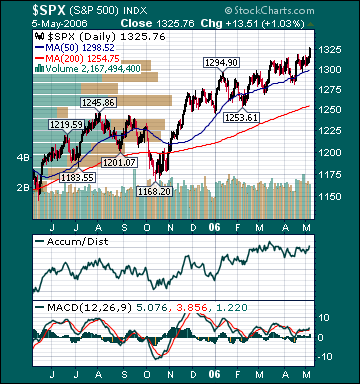
BOTTOM LINE: Overall, last week's market performance was bullish. The advance/decline line rose, almost every sector gained and volume was above average on the week. Measures of investor anxiety were mostly lower. The AAII % Bulls rose to 45.89%, but is still only around average levels, which is a positive considering the DJIA is only 172 points away from an all-time high. The average 30-year mortgage rate rose to 6.59% which is 138 basis points above all-time lows set in June 2003. I still believe housing is in the process of slowing to more healthy sustainable levels. This will likely result in the slowing of consumer spending, and thus US GDP growth, back to around average rates over the coming months. The benchmark 10-year T-note yield rose 5 basis points on the week as economic data mostly exceeded expectations, the US dollar declined and measures of inflation rose. I still expect inflation concerns to begin declining again later this quarter as economic growth slows, unit labor costs remain subdued and the mania for commodities reverses course. The 10-year yield is probably close to a peak for the year.
Unleaded Gasoline futures fell this week and are 30.1% below September 2005 highs even as refinery utilization remains below normal as a result of the hurricanes last year, 21.6% of Gulf of Mexico oil production remains shut-in and fears over Iranian/Nigerian production disruptions persist. The mandated switch from MTBE-based reformulated gasoline to ethanol-based fuel had been the main reason behind the recent spike in gas prices. President Bush’s decision to authorize the temporary waiver of this mandate should continue to quell gasoline shortage fears.
The American Petroleum Institute recently said US oil demand fell 2.6% in March, notwithstanding blistering economic growth of 4.8% during the first quarter. This is a result of conservation, substitution and demand destruction. Ford Motor reported this week that sales for the Explorer, America’s top-selling SUV, plunged 42% in April. Moreover, sales of Ford’s more fuel-efficient models remained brisk. Demand for gasoline is decelerating markedly and the recent rise related to shortage speculation should further dampen demand over the coming months, sending gas prices back to reasonable levels.
Natural gas inventories rose less than expectations this week, but supplies are still 58.0% above the 5-year average, near an all-time record high for this time of year, even as 12.95% of daily Gulf of Mexico production remains shut-in. Natural gas prices have plunged 57.0% since December 2005 highs. Notwithstanding this collapse, industrial demand for natural gas has shown few signs of increasing. US oil inventories are now approaching 9-year highs. Since November 2004, global oil demand has only increased 1.07%, while global supplies have increased 4.57%. Moreover, worldwide oil inventories are poised to begin increasing at an accelerated rate over the next year as Cambridge Energy Research outlined here. I continue to believe oil is priced at extremely elevated levels on fear and record speculation by investment funds, not fundamentals. As the fear premium in oil dissipates back to more reasonable levels and supplies continue to rise, I still expect crude to head meaningfully lower over the intermediate-term.
Gold rose for the week as the US dollar declined, inflation measures rose and economic data mostly exceeded estimates. The US dollar fell on continuing speculation over a Fed “pause” and hawkish commentary from the European Central Bank. I expect the dollar to begin to firm over the next few months.
The most economically sensitive stocks outperformed substantially for the week as investors continue to extrapolate recent robust economic growth into the future. S&P 500 earnings growth for the 1st quarter is up about 14.3% year-over-year so far, about double the long-term average and substantially above expectations of 8-9% growth just a few weeks ago. As well, 67% of companies have exceeded estimates versus the long-term average of 57%. This is the 16th consecutive quarter of double-digit profit growth, the best streak since record-keeping began in 1936. The forward p/e on the S&P 500 has contracted relentlessly during this time period and now stands at a very reasonable 15.5.
The average US stock, as measured by the Value Line Geometric Index(VGY), is up a very strong 10.8% so far this year. Moreover, the Russell 2000 Index is up 16.53% year-to-date. The S&P 500 is 7.0% higher for the year, about half way to my projection of a 15% gain. This is with oil trading above $70/bbl. and interest rates moving higher. If we get a meaningful reversal lower in either or both, my 15% total return prediction for the year may prove conservative. The ECRI Weekly Leading Index rose this week and is still forecasting healthy US economic activity.
*5-day % Change
No comments:
Post a Comment